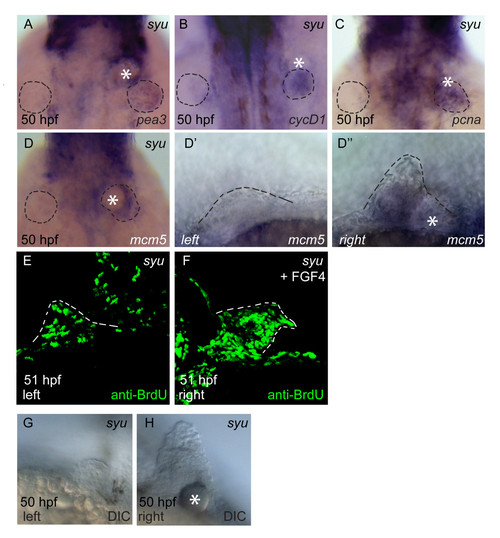- Title
-
Distinct roles of Shh and Fgf signaling in regulating cell proliferation during zebrafish pectoral fin development
- Authors
- Prykhozhij, S.V., and Neumann, C.J.
- Source
- Full text @ BMC Dev. Biol.
|
G1- and S-phase cell-cycle gene expression in fin buds of sonic-you mutant correlates with the Fgf signaling status. Wild-type embryos and sonic-you mutant embryos (in which the zebrafish shh gene is disrupted) at 32 hpf (A-L) and 38 hpf (M-Y) were analysed for expression of the Shh target patched1(ptc1) (A, G, M; T), the Fgf target pea3 (B, H, N, U), the cell-cycle genes cyclinD1, pcna, and mcm5 (C-E, I-K, O-R, V-X), and replication protein A1(ra1) (F, L, S, Y). The Shh target ptc1 was expressed in the posterior part of wild-type fin buds at 32 and 38 hpf stages (A, M), but its expresssion was absent in sonic-you mutant fin buds (G, T). The Fgf signaling target pea3 was expressed at comparable levels in wild-type and sonic-you fin buds at 32 hpf stage (B, H). At 38 hpf pea3 was still strongly expressed in the wild-type fin buds (N), but almost completely downregulated in the sonic-you mutant fin buds (U). cyclinD1, pcna and mcm5 were expressed strongly in both wild-type and sonic-you fin buds at 32 hpf stage (C-E, I-K). At 38 hpf these genes were still strongly expressed in the wild-type fin buds (O-R), but downregulated in the sonic-you mutant fin buds (V-X). Expression of ra1 was similar in both wild-type and sonic-you fin buds at 32 and 38 hpf stages. |
|
Expression of G1- and S-phase cell-cycle genes fails to correlate with the status of Shh signaling in fin buds. Wild-type embryos were treated with 100 μM cyclopamine (cyA) (G-L, T-Y) or with the carrier 0,5% ethanol (EtOH) (A-F, M-S) for 6 hours from 34 to 40 hpf (A-L) or for 13 hours from 34 to 47 hpf (M-Y) and analysed for the expression of ptc1, pea3, cyclinD1, pcna, mcm5 and ra1. Expression of ptc1 was nearly completely lost after both 6 hours (A, G) and 13 hours (M, T) inhibition pulses. A 6-hour Hedgehog signaling inhibition led to a small change in pea3 expression in fin buds (B, H). Comparably small changes in expression after 6-hour Hedgehog signaling inhibition were observed for cyclinD1, pcna, mcm5 and ra1 (C-F, I-L). After 13-hour Hedgehog signaling inhibition, fin bud pea3 expression was strongly decreased (N, U). Likewise, expression of cyclinD1, pcna and mcm5 in fin buds was strongly downregulated (O-R, V-X). Expression of ra1gene was only mildly affected by 13-hour cyclopamine treatment (S, Y). |
|
Inhibition of Fgf signaling causes rapid loss of G1- and S-phase cell-cycle gene expression, and blocks S-phase progression. Wild-type embryos were treated with 10 μM SU5402 (D-F, J-L, M, N) or the carrier 0,125% DMSO (A-C, G-I, O, P) for 3 hours from 36 to 39 hpf. For BrdU stainings, after 3-hour treatment with either SU5402 or DMSO, embryos were injected with 10 mM BrdU solution into the yolk and incubated for 1 hour in the same solutions before fixation. SU5402 treatment strongly downregulated the expression of pea3 FGF signaling target (A, D), but had only a small effect on ptc1 expression in fin buds (B, E). SU5402 treatment also caused strong downregulation of cyclinD1 (C, F), pcna (G, J) and mcm5 (H, K). Expression of ra1 was not affected by SU5402 treatment (I, L). S-phase progression, as revealed by BrdU labelling, was strongly inhibited after SU5402 treatment, in comparison to control embryos (n = 10, at least 2 fin sections per embryo were analysed) (M, N). EXPRESSION / LABELING:
|
|
Fgf signaling inhibition does not cause global downregulation of G1- and S-phase cell-cycle gene expression. Wild-type embryos were treated with 10 μM SU5402 (A-E) or the carrier 0,125% DMSO (F-J) for 3 hours from 20 to 23 hpf. SU5402 treatment caused a strong downregulation of pea3 gene expression (A, F), but expression of cyclinD1, pcna, mcm5 and ra1 genes was not changed in SU5402-treated embryos compared to control ones (B-E, G-J). EXPRESSION / LABELING:
PHENOTYPE:
|
|
Implantation of FGF4-soaked beads rescues G1- and S-phase cell-cycle gene expression and S-phase progression in sonic-you fin buds. Fin buds on the right hand side of sonic-you embryos were implanted with FGF4-soaked heparin beads at 29?32 hpf, grown until 50 hpf and fixed (A-D, F-H). For anti-BrdU staining, embryos were first implanted and then injected with 10 mM BrdU solution at 38 hpf before fixation at 50 hpf. Sonic-you embryos show upregulation of pea3 (A), cyclinD1 (B), pcna (C) and mcm5 (D) expression in response to the FGF4-soaked beads on the implanted side. Fin buds are outlined by dotted lines in panels A to D. A non-implanted fin bud on the left hand side shows no mcm5 expression (D′), while an implanted fin bud on the right hand side of the same embryo (D″) shows restored mcm5 expression. A non-implanted fin bud shows few BrdU-labeled nuclei (E), while an FGF4 bead-implanted fin bud (F) has extensive BrdU labeling (sections of both sides of 10 bead-implanted embryos were analysed). Fin buds implanted with FGF4 beads show increased outgrowth (D″, F, H), compared to non-implanted control fin buds (D′, E, G). |





